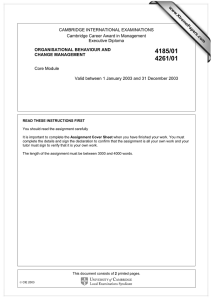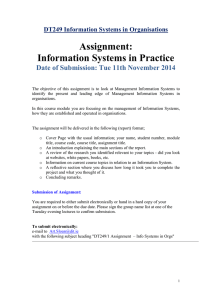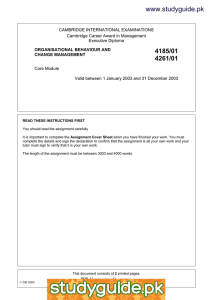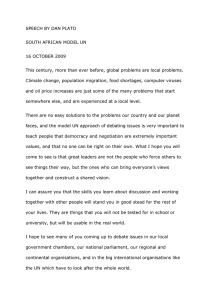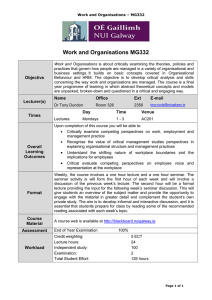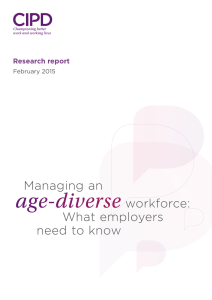new A way of working
advertisement
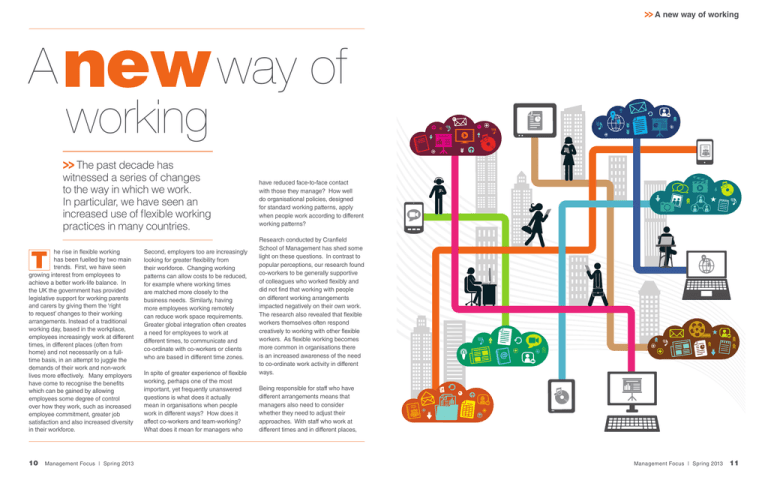
A new way of >> A new way of working working >> The past decade has witnessed a series of changes to the way in which we work. In particular, we have seen an increased use of flexible working practices in many countries. T he rise in flexible working has been fuelled by two main trends. First, we have seen growing interest from employees to achieve a better work-life balance. In the UK the government has provided legislative support for working parents and carers by giving them the ‘right to request’ changes to their working arrangements. Instead of a traditional working day, based in the workplace, employees increasingly work at different times, in different places (often from home) and not necessarily on a fulltime basis, in an attempt to juggle the demands of their work and non-work lives more effectively. Many employers have come to recognise the benefits which can be gained by allowing employees some degree of control over how they work, such as increased employee commitment, greater job satisfaction and also increased diversity in their workforce. 10 Management Focus | Spring 2013 Second, employers too are increasingly looking for greater flexibility from their workforce. Changing working patterns can allow costs to be reduced, for example where working times are matched more closely to the business needs. Similarly, having more employees working remotely can reduce work space requirements. Greater global integration often creates a need for employees to work at different times, to communicate and co-ordinate with co-workers or clients who are based in different time zones. In spite of greater experience of flexible working, perhaps one of the most important, yet frequently unanswered questions is what does it actually mean in organisations when people work in different ways? How does it affect co-workers and team-working? What does it mean for managers who have reduced face-to-face contact with those they manage? How well do organisational policies, designed for standard working patterns, apply when people work according to different working patterns? Research conducted by Cranfield School of Management has shed some light on these questions. In contrast to popular perceptions, our research found co-workers to be generally supportive of colleagues who worked flexibly and did not find that working with people on different working arrangements impacted negatively on their own work. The research also revealed that flexible workers themselves often respond creatively to working with other flexible workers. As flexible working becomes more common in organisations there is an increased awareness of the need to co-ordinate work activity in different ways. Being responsible for staff who have different arrangements means that managers also need to consider whether they need to adjust their approaches. With staff who work at different times and in different places, Management Focus | Spring 2013 11 >> A new way of working managers have less opportunity to observe what they actually do. In order to manage the performance of these staff, it becomes more important to focus on the outcomes they deliver, rather than how they actually spend their time. Communication with employees also changes when people work in different ways. Managers may have to place greater emphasis on effective communication, since there are fewer opportunities for reinforcement. Beyond formal communication, it is also important to create opportunities for the kind of communication which traditionally takes place in ‘corridor conversations’ in workplaces. In order not to lose this form of communication managers might schedule relatively un-structured ‘catch-up’ time with employees to allow space for conversations of this kind to emerge. Organisational policies designed for traditional modes of working are likely to require some adjustment to take account of different working patterns. Promotion decisions which rely, at least in part, on ‘visibility’ in an organisation are likely to disadvantage flexible workers and may need to be re-oriented so that the case for progression of flexible and non-flexible workers can be considered fairly. At a more subtle level, there may be implications for the types of training needed. When employees are co-located in a workplace, there are many unscheduled opportunities for them to learn from one another. For example, an employee may learn by overhearing or watching how a co-worker deals with a particular situation. When they are not physically in the same location many of these opportunities are lost. However, this 12 Management Focus | Spring 2013 is not of course an insurmountable problem. If organisations are aware of what is lost, training can be put in place to replace this kind of informal learning which takes place in the workplace. Overall, there needs to be careful consideration of what the full implications of employees working in different ways are and how organisational policies and practice need to change in light of this. Today most organisations have some experience of flexible working and recognise the business benefits which can be gained from employees working in different ways. For many, these go beyond increasing diversity in their workforce and include heighted levels of employee motivation and engagement. There is now, however, a need to review their experiences and to re-evaluate policies and practices in order to maximise the opportunity for positive outcomes and reduce the possibilities of negative outcomes and as a result for flexible working to become more widely accepted. “Greater global integration creates a need for employees to work at different times.” As many organisations seek greater flexibility from their employees, in order to increase efficiency in difficult economic circumstances, it is time to explore fully how the desire for flexibility on the part of employees and the need for flexibility from the employers can be reconciled in different organisations. MF Dr Clare Kelliher is a Professor of Work and Organisation at Cranfield. Management Focus | Spring 2013 13

